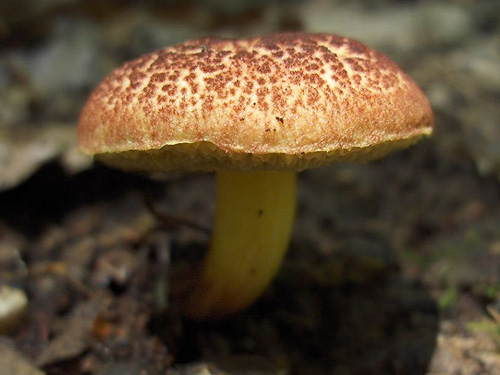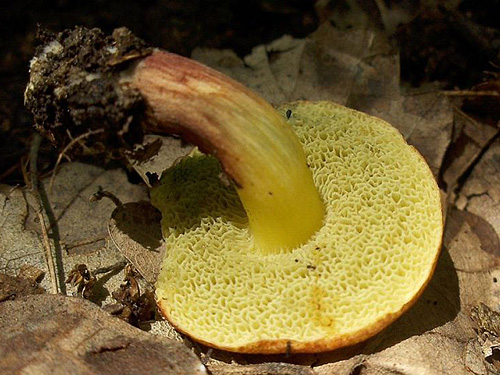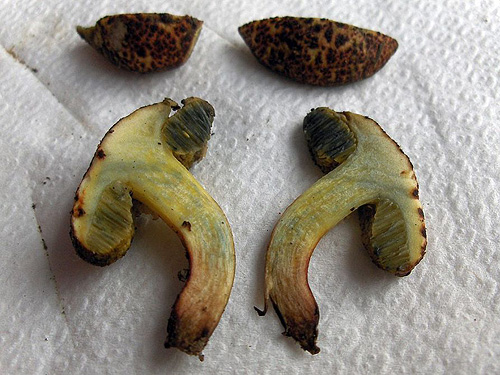Xerocomus Quél.
Recent molecular studies have shown that Xerocomus in its current circumscription is likely an artificial grouping and it is possible that it will be split at some point into smaller genera. Molecular studies also have changed our understanding about the species of xerocomoid boletes showing that morphological features are quite variable in this group. Not only microscopic study is essential for determination, but scanning electron microscope will be often needed in this “genus” as the spore ornamentation is not always seen under ordinary light microscope. Do bear in mind that macroscopic characters, such as colours, cracking cuticle, etc., tend to intergrade between the different species. Note that Boletus impolitus and Boletus depilatus that were shown to be close to Xerocomus subtomentosus and its allies, are here retained in Boletus for practical reasons. The same applies also for Phylloporus pelletieri, placed here in a genus of its own, but being also close to Xerocomus subtomentosus group.
Although large reference list will be found under most of the species, one should always consult Ladurner & Simonini (2003) having in mind that there are some new species (X. chrysonemus, X. marekii, X. silwoodensis) described after this otherwise superior book was printed. Useful keys, covering most of the European xerocomoid boletes (except some southern taxa) are provided by Knudsen & Vesterholt (2008), Hills (2008) and Kibby (2011), the later also featuring an excellent comparison chart.
Fruitbody medium to small sized, boletoid, without veil and ring. Some southern species have secondarily angiocarpic development and then a ring of coarse granules is observed on the stipe, where the cap margin was initially attached. Stipe solid, often tapering towards the base. Flesh variously coloured, changing or not when exposed to air. Tubes not separable from each other, instead tearing apart. Pores usually angular.
Xerocomus marekii (Šutara & Skála) Klofac
Description
Recently described and known to me only by the descriptions and the photographs, published by Šutara & Skála (2007) and Šutara & al. (2009).
Cap up to 6.5 cm, at first hemispherical then convex, orange red, bright red to vinaceous red, dry, velvety and soon cracking. Stipe cylindrical or club-shaped, often curved at the base, pale yellow to yellow, at the lower half with reddish tint. Flesh yellowish, yellow above the tubes, somewhat reddish or vinaceous in the lower half of the stipe, blueing when exposed to air. Smell not distinctive. Taste not distinctive. Spores 10.5–19 × 4.5–7.5 μm, smooth, truncate. Pileipellis (the cap cuticle) a palisadoderm of septate hyphae. Hyphae composed of nearly ellipsoid to cylindrical, incrusted cells.
Habitat. In deciduous forests, mycorrhizal probably with oaks (Quercus).
Distribution. So far known only from the Czech Republic and Hungary. It is possibly more widespread but overlooked and it should be looked for.
Similarity. Xerocomus marekii shows similarity to many other xerocomoid species with red-coloured caps.
Xerocomus rubellus is distinguished by the characteristic bright orange red spots in the base of the stipe and also by its non-truncate spores.
Xerocomus ripariellus is distinguished on the base of its striate non-truncate spores.
Xerocomus fennicus also has truncate, but striate spores.
Xerocomus porosporus has truncate, smooth spores, but is distinguished by the differently coloured cap and stipe that do not show red tints.
Xerocomus dryophilus has non-truncate, smooth spores.
Xerocomus silwoodensis (belonging to the X. subtomentosus – group) has not blueing flesh and non-truncate, smooth spores.
Xerocomus cisalpinus also has red forms, but it has striate, non-truncate spores
Photographs

Fully developed fruitbody of Xerocomus marekii (photo L. Kaposvári)

Fruitbody of Xerocomus marekii - lower side (photo L. Kaposvári)

Xerocomus marekii - colour of the flesh (photo L. Kaposvári)
As most of the species of this genus, X. marekii is apparently very variable fungus. Martin Kříž on the Slovak site Nahuby presents a photograph of a young fruitbody. Click here to see it. Illustrations of the microscopic features and some more colour photos are published in Šutara & Skála (2007), Šutara & al. (2009) and Dima & Albert (2009).
Important literature
Dima, B. & Albert, L. 2009. A Xerocomus marekii első Magyarországi előfordulása – Clusiana 48(1): 5–10. (available online)
Klofac, W. 2007. Schlüssel zur Bestimmung von Frischfunden der europäischen Arten der Boletales mit röhrigem Hymenophor. – Österreichische Zeitschrift für Pilzkunde 16: 187–279.
Šutara, J., Mikšík, M. & Janda, V. 2009. Hřibovité houby. Čeled’ Boletaceae a rody Gyrodon, Gyroporus, Boletinus a Suillus. Academia, Praha.
Šutara, J. 2008. Xerocomus s. l. in the light of the present state of knowledge. – Czech Mycology 60: 29–62. (available online)
Šutara, J. & Skála, E. 2007. Boletus marekii, a new species with truncate spores from the Boletus chrysenteron group – Czech Mycology 59(1): 11–24. (available online)